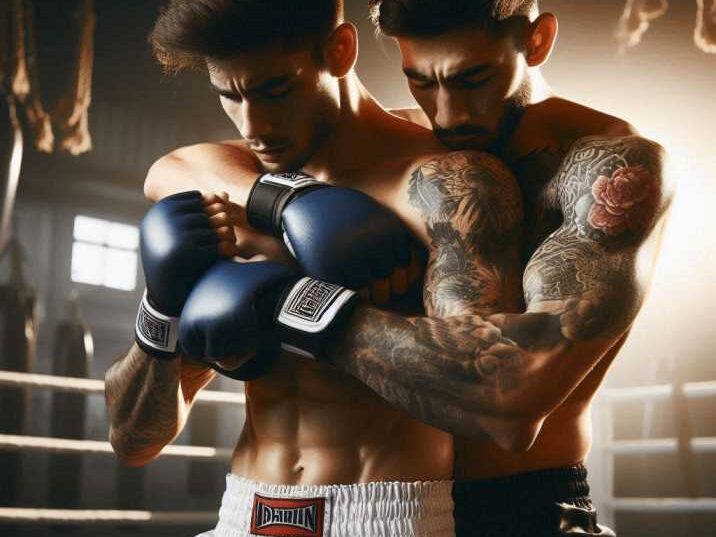Introduction
Table of Contents
Muay Thai, known as the “Art of Eight Limbs,” is famous for its powerful strikes using fists, elbows, knees, and shins. But does this ancient Thai martial art include grappling techniques? In this article, we’ll explore how grappling is integrated into Muay Thai, focusing on the clinch—a key component of the sport. We’ll explain what clinching is, how it is used in Muay Thai, and compare it to grappling in other martial arts.

What is Muay Thai?
Muay Thai is a traditional martial art from Thailand that combines striking techniques with clinch work. Practiced for centuries, it is both a sport and a method of self-defense. Muay Thai practitioners use their fists, elbows, knees, and shins to deliver powerful blows. The clinch is a unique aspect of Muay Thai that sets it apart from other striking martial arts.
Understanding Grappling in Muay Thai
The Clinch: Muay Thai’s Unique Grappling Technique
The clinch in Muay Thai is a form of grappling that involves close-quarters fighting. Unlike grappling arts such as Brazilian Jiu-Jitsu (BJJ) or wrestling, where the focus is primarily on takedowns and submissions, the Muay Thai clinch is used to control the opponent and create opportunities for strikes.
Key Features of the Muay Thai Clinch
1. Control
In Muay Thai, the clinch is a strategic position where fighters can dominate their opponent by controlling their head and body. Here’s how it works:
- Head Control: Fighters use their hands to grip the opponent’s head, often placing their arms around the neck or behind the head. This grip restricts the opponent’s movement and makes it difficult for them to strike effectively or escape.
- Body Control: By wrapping their arms around the opponent’s body or using their elbows to press against the opponent’s torso, fighters can limit the opponent’s ability to move. This control creates openings for strikes and helps maintain dominance in the clinch.
Overall, controlling the opponent in the clinch is essential for both defense and setting up offensive techniques.
2. Knee Strikes
Knee strikes are a fundamental aspect of the Muay Thai clinch, and they play a crucial role in scoring points and inflicting damage:
- Target Areas: Fighters deliver knee strikes to the opponent’s body, particularly the midsection and ribs, as well as to the head. Targeting these areas can cause significant pain and disrupt the opponent’s rhythm.
- Technique: While in the clinch, fighters use their knee to drive upward or forward into the opponent’s body. The power generated from this close-range attack can be very impactful, making it a valuable tool in the clinch.
- Purpose: Knee strikes can wear down the opponent, create openings for other strikes, and score points in competitive matches.
3. Elbow Strikes
Elbow strikes are another powerful tool used in the Muay Thai clinch:
- Close-Range Attacks: Elbows are employed in close quarters to deliver sharp, precise strikes. Unlike punches, elbows can cause cuts and bruises with their edge, adding an element of danger in the clinch.
- Techniques: Fighters can use their elbows to strike across the opponent’s head or face, or to deliver downward, sideways, or diagonal blows. These strikes are designed to break through the opponent’s defenses and cause damage.
- Effectiveness: Elbow strikes are effective for inflicting quick, debilitating damage and can be especially useful in close-range exchanges where other strikes might be less effective.
4. Sweeps
Sweeps are techniques used to off-balance the opponent and create opportunities for takedowns or further attacks:
- Off-Balancing: Fighters use their body weight and positioning in the clinch to unbalance the opponent. This might involve pushing, pulling, or shifting weight to disrupt the opponent’s stance and stability.
- Execution: By using precise movements and leveraging their own body weight, fighters can perform sweeps to cause the opponent to fall or stumble. This can lead to a takedown or create a chance to strike from a more advantageous position.
- Advantages: Successful sweeps can gain points in a match, create openings for more powerful attacks, and demonstrate control and skill in the clinch.
Comparison with Other Martial Arts
Brazilian Jiu-Jitsu (BJJ)
Brazilian Jiu-Jitsu focuses on ground fighting and submissions. Grappling in BJJ involves techniques such as joint locks and chokes, which are not a part of Muay Thai. BJJ practitioners aim to take their opponents to the ground and secure a submission victory.
Wrestling
Wrestling involves a variety of takedowns and pins. Like BJJ, wrestling emphasizes controlling the opponent’s movement and often aims to bring the fight to the ground. Unlike Muay Thai, wrestling does not include striking techniques.
Judo
Judo is a martial art focused on throws and takedowns. While judo includes some grappling techniques similar to those in the Muay Thai clinch, its primary goal is to unbalance and throw the opponent rather than to strike.
The Role of Clinching in Muay Thai Matches
Benefits of Clinching in Muay Thai
1. Control the Fight
In Muay Thai, clinching is a crucial technique for controlling the fight. Here’s how it helps:
- Neutralizing Strikes: By engaging in the clinch, fighters can limit their opponent’s ability to use powerful strikes like punches and kicks. The close contact makes it difficult for the opponent to generate the force needed for effective striking.
- Pace Control: The clinch allows fighters to dictate the pace of the match. By maintaining control, a fighter can slow down an aggressive opponent or create a pause in the action to catch their breath and strategize.
- Strategic Advantage: Controlling the opponent in the clinch also gives a fighter the opportunity to position themselves advantageously, making it harder for the opponent to execute their own game plan.
2. Create Opportunities for Strikes
The clinch isn’t just about control; it’s also a strategic position to launch effective strikes:
- Setting Up Knee Strikes: In the clinch, fighters can use their control over the opponent’s body to set up powerful knee strikes. By holding the opponent in place, they can deliver knees to the body or head with maximum impact.
- Elbow Strikes: The clinch allows for close-range elbow strikes, which can be particularly damaging. These strikes are often delivered with precision and can catch the opponent off guard.
- Scoring Points: Effective striking from the clinch can help a fighter score points in a match, making it an important aspect of scoring and winning.
3. Defensive Tactic
The clinch is also a valuable defensive tool:
- Closing the Distance: By engaging in the clinch, fighters can close the distance between themselves and their opponent. This reduces the effectiveness of long-range attacks and kicks.
- Avoiding Strikes: The clinch can be used to shield against incoming strikes and reduce the chances of getting hit. It serves as a way to mitigate the opponent’s offensive strategies.
- Protective Measure: Using the clinch effectively can help a fighter defend against powerful attacks and minimize damage during high-pressure moments in the match.
Training for the Clinch
To become proficient in clinch techniques, Muay Thai fighters undergo extensive training. This training typically includes:
1. Drills
- Purpose: Drills are designed to practice clinch positions and transitions. Fighters work with a partner to simulate clinch scenarios, focusing on technique, timing, and control.
- Types: Drills might include repetitive clinch holds, positioning exercises, and practicing specific clinch maneuvers like knee strikes and sweeps.
- Benefits: Regular drilling helps fighters develop muscle memory and improve their ability to execute clinch techniques effectively during a match.
2. Bag Work
- Purpose: Heavy bags are used to simulate clinch scenarios and practice strikes in a controlled environment.
- Techniques: Fighters perform clinch drills on the heavy bag, practicing knee and elbow strikes while maintaining control. This helps in developing power and precision.
- Benefits: Bag work allows fighters to refine their technique, build strength, and simulate the physical demands of clinching in a fight.
3. Sparring
- Purpose: Sparring sessions provide a real fight context where fighters can apply clinch techniques against a resisting opponent.
- Controlled Environment: Sparring is done in a controlled manner, with both partners working on their clinch skills while ensuring safety.
- Benefits: Engaging in sparring helps fighters adapt their clinch techniques to dynamic situations, test their skills under pressure, and improve their overall clinch game.
Table of Information
| Martial Art | Focus | Grappling Techniques | Striking Techniques |
|---|---|---|---|
| Muay Thai | Striking with clinch | Clinch control, knee strikes | Elbows, knees, shins |
| Brazilian Jiu-Jitsu | Ground fighting and submissions | Joint locks, chokes | None |
| Wrestling | Takedowns and pins | Various takedowns, pins | None |
| Judo | Throws and takedowns | Throws, grappling | None |
Conclusion
In summary, while Muay Thai is primarily known for its striking techniques, grappling does play a significant role through the use of the clinch. This unique form of grappling allows Muay Thai fighters to control their opponents, deliver powerful strikes, and use strategic maneuvers to gain an advantage. Unlike other martial arts that focus solely on grappling or striking, Muay Thai blends both elements to create a dynamic and effective fighting style.
FAQs
1. What is the clinch in Muay Thai?
The clinch in Muay Thai is a grappling technique used to control an opponent and set up knee and elbow strikes.
2. Does Muay Thai include ground fighting?
No, Muay Thai focuses on striking and clinch work, not ground fighting.
3. How does Muay Thai grappling differ from BJJ?
Muay Thai grappling, or clinching, focuses on control and striking, while BJJ emphasizes submissions and ground control.
4. Can Muay Thai fighters use wrestling techniques?
Muay Thai fighters primarily use clinch techniques, but some wrestling techniques like sweeps may be incorporated.
5. Is clinching allowed in Muay Thai competitions?
Yes, clinching is a crucial part of Muay Thai competitions and is used to control opponents and deliver strikes.


